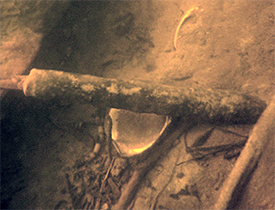ECU's 2006 Fall Field School
Project Journal
27 September 2006
By Adam Friedman

Looking back over the field journal entries, the first half almost all recounted the troubleshooting and lower order activities that characterize most archaeological projects, especially those that occur underwater. As the first week closed, potential toxins were discovered at Site A, and the audience to these daily synopses received an unfair double helping of our online “oops!” as we moved to Site B and began extensively dredging for a second time. Considerable progress has been made in mapping the Padgett vessel. By the end of today, almost every grid square arrayed along the centerline baseline was completed or nearly so. With sufficient evidence collected, we have now begun to take a step back from our planks and frames, venturing to understand the construction of the entire vessel.

The two holes on this wooden timber show evidence of fasteners, and help archaeologists understand how the vessel was constructed.
Joe’s adroitness with the dredge has exposed substantial portions of the stem and stern deadwood assembly. While taking care not to remove too much of the supporting sediment, which would cause structural failure, the keel has been exposed in parts. This will allow us to record the cross sections of these deadwood assemblies, and some of these drawings were started today. Aside from stem and stern, one midsection cross section will be drawn. At one point alongside the centerboard trunk on the starboard side, the garboard strake is missing. This hole, intentional or not, has permitted access to the keel without damage to the vessel remains.
In the course of creating the plan view of the site, the frames supporting the aft portion of the centerboard trunk and the hull further aft were found to be placed side by side, forming a continuous hull wall. The only gaps between the frames occur every third or fourth frame with the presence of small wooden spacers between the frames, measuring about 0.05 tenths of a foot. Analysis of this framing system on the starboard side revealed that this is likely a system of offset frame pairs; multiple floor futtocks that do not continue above the turn of the bilge and fill the spaces between the frames that do. This may have supported the weight of the centerboard trunk and aft portions of the hull after loaded with cargo.

A possible lantern pane photographed in situ.
Chris Padgett, owner of Site B, showed us an artifact that drifted ashore from the vessel site. The artifact was a semicircular curved pane of blue-green glass, possibly 0.05 tenths of foot thick with smooth, unbroken edges. At the top and bottom, there are three ridges running along the semicircular face. It looks suspiciously like a lantern pane and is similar to two artifacts found and left in situ for the moment on the wreck – portions of a clear and red glass pane. This seems to suggest that if the artifacts are original to the site, the vessel sported red, blue, and white signal lanterns. The glass itself is mostly free from manufacturing imperfections but three small bubbles are present on the blue-green pane. Investigation of the manufacturing process and of the maritime signal lanterns system could aid in providing a date for the vessel.

A fastener in situ representative of the type primarily found on site. Observe the metal point in the middle left portruding from years of encrustation.
I have only provided a few examples of the material culture and aspects of vessel construction that are sparking neurons on this project. As evidence is accumulated and analyzed, additional working hypotheses will be tested, proven, disproven, and developed. Our goal is to begin seeing the vessel in historical context. Perhaps what we learn during these last days in the field, and those following in the office, will allow the vessel to answer questions concerning ship construction techniques of this era, the trades and economy of Washington and the surrounding region, and the importance of Washington to Beaufort County and North Carolina, just to name a few. Our heads are no longer six inches from a plank but rather six seconds from a new idea.
For more information you can visit the ECU website at:
http://www.ecu.edu/maritime/index.htm
Return to Project Journal home page.

